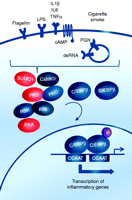The emerging role of C/EBPs in glucocorticoid signaling: lessons from the lung
-
Figure 1
C/EBPs are involved in multiple innate immunity signaling pathways. C/EBPβ has been implicated in signaling pathways evoked by several inflammatory stimuli, including LPS that binds to TLR4; cytokines acting via their respective receptors; bacterial flagellin binding to TLR5; cAMP acting via G-coupled receptors and cigarette smoke as well as dsRNA and PNG that binds to TLR3 and the Nod1 receptor present on intracellular endosomes. C/EBPs are activated via post-transcriptional modification and hetero- or homodimerize. A number of enzymes have been demonstrated to activate C/EBPs by phosphorylating (p38, RSK, CaMKII, and PKC) the transcription factors. Some post-transcriptional modifications, including phosphorylation by PKA and PKC, reduce DNA-binding activity (enzymes indicated in red), and sumoylation leads to repression of COX2 transcription. Activated C/EBPβ bind DNA and can induce transcription of pro-inflammatory genes. CaMII, Ca2+/calmodulin-dependent protein kinase; C/EBP, CCAAT/enhancer-binding protein; dsRNA, double-stranded RNA; IL, interleukin; LPS, lipopolysaccharide; Nod, nucleotide-binding oligomerization domain-containing protein; PNG, peptidoglycan; PK, protein kinase; RSK, ribosomal S6 kinase; SUMO, small ubiquitin-related modifier; TLR, Toll-like receptor.
-
Figure 2
GCs increase DNA-binding activity of C/EBPβ by post-transcriptional modification. Activation increases transcription of lung-specific genes lacking GRE in the promoter. This activation may target C/EBPβ toward promoters of GC-activated, anti-inflammatory genes, but not toward promoters of pro-inflammatory genes. C/EBP, CCAAT/enhancer-binding protein; GC, glucocorticoid; GRE, glucocorticoid-responsive element.
-
Figure 3
Different post-transcriptional modifications leading to binding of alternative C/EBP-responsive elements – a putative model for the dual role of C/EBPβ in inhibiting and mediating the inflammatory response. Inflammatory and anti-inflammatory (GC) stimuli may induce different post-transcriptional modifications (such as phosphorylations at different positions, sumoylations, or acetylations) and direct C/EBPβ to activate or repress inflammatory gene transcription or induce anti-inflammatory/host defense gene transcription. (A) Inflammatory signaling induces post-transcriptional modifications (indicated in purple) that activate C/EBPβ and promote binding to C/EBP-responsive elements stimulating transcription of pro-inflammatory genes. (B) GC-induced post-transcriptional modifications (indicated in red) direct C/EBPβ to bind negative regulatory DNA sequences (indicated in red), inhibiting gene transcription. (C) GCs induce post-transcriptional modification of C/EBPβ (indicated in blue) to target C/EBP-responsive elements of anti-inflammatory and/or host defense genes lacking GREs, not elements in promoters of inflammatory genes. C/EBP, CCAAT/enhancer-binding protein; GC, glucocorticoid; GRE, glucocorticoid-responsive element.
-
Figure 4
GC induction of different transcription factor interactions – a proposed model explaining C/EBPβ mediation of anti-inflammatory and pro-inflammatory signaling. C/EBP family members hetero- or homodimerize and also interact with other transcription factors including the GR. Anti-inflammatory signaling evoked by GCs may result in different types of dimers than inflammatory signaling. (A) GC signaling leads to C/EBP and GR binding of adjacent responsive elements of GRE- and C/EBP-responsive genes (e.g. AGP). PPARα can bind to C/EBPβ upon stimulation with PPARα agonists, and binding to C/EBP-responsive elements is prevented. (B) The activated GR binds C/EBPβ and prevents DNA binding to responsive elements and subsequent transcription (e.g. of the IL1β gene). (C) The GC receptor induces different C/EBP hetero- or homodimers and transcription of C/EBP-responsive genes. Different heterodimers may result in pro- or anti-inflammatory signaling. AGP, α1-acid glycoprotein; C/EBP, CCAAT/enhancer-binding protein; GC, glucocorticoid; GR, glucocorticoid receptor; GRE, glucocorticoid-responsive element; IL, interleukin; PPAR, peroxisome proliferator-activated receptor.
- © 2012 Society for Endocrinology













